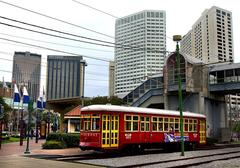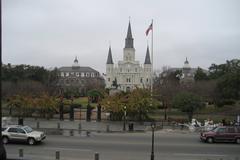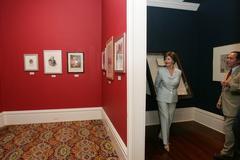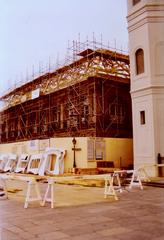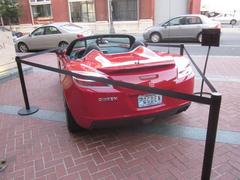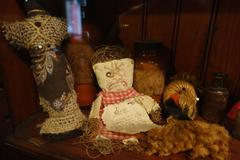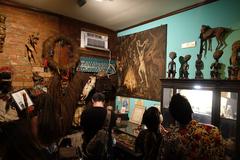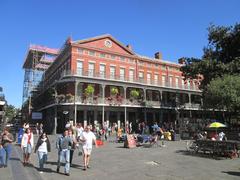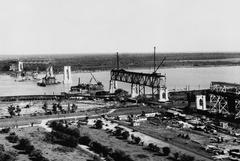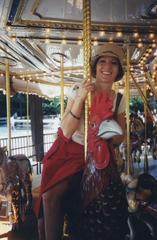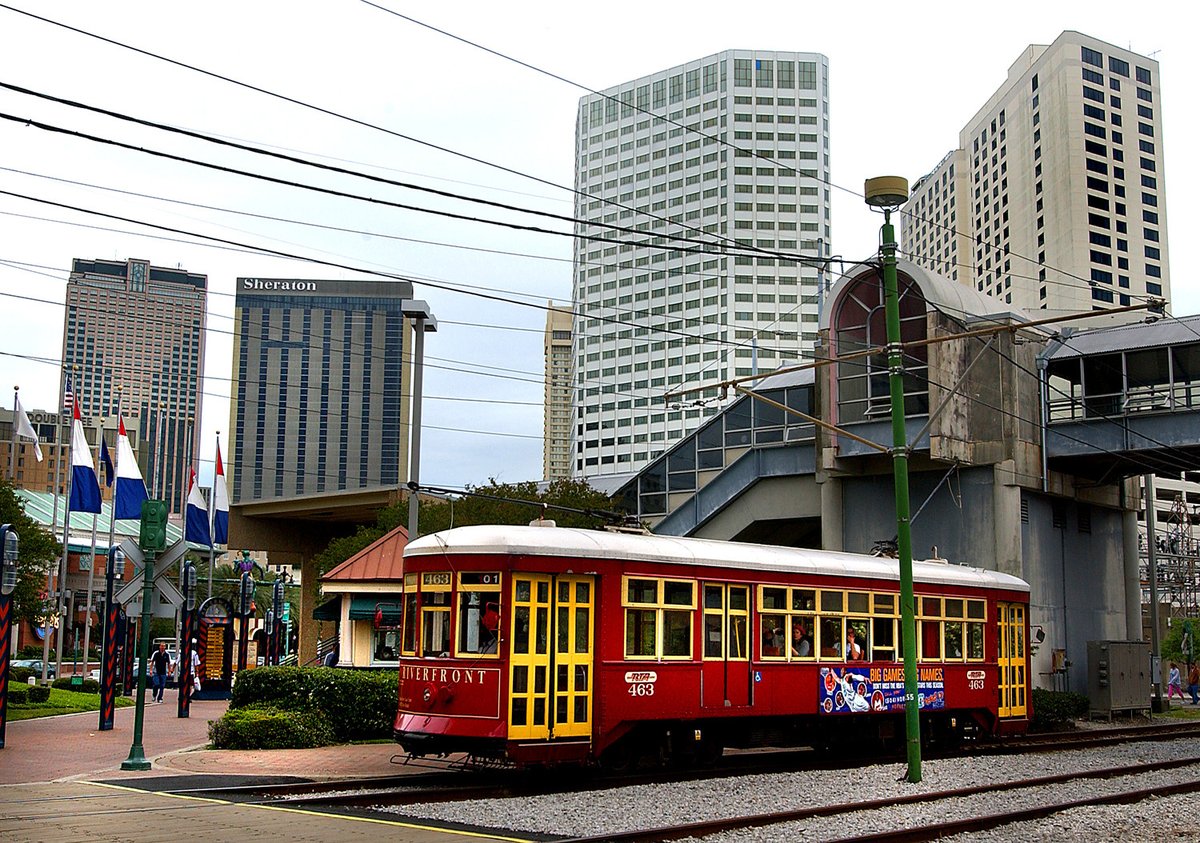
Visiting Moonwalk in New Orleans: Hours, Tickets, and Tips
Date: 01/08/2024
Introduction
The Moonwalk in New Orleans is not just a simple promenade; it is a vibrant confluence of history, culture, and unparalleled scenic beauty. Located along the majestic Mississippi River, this iconic walkway offers a unique vantage point to observe the city’s bustling maritime activity. Established in the 1970s and named after Mayor Maurice ‘Moon’ Landrieu, the Moonwalk revitalized New Orleans’ connection with its historic riverfront, which had been largely inaccessible due to industrial developments (A View on Cities). Today, the Moonwalk stands as a testament to the city’s resilience and dedication to preserving its rich cultural heritage. Visitors to this scenic promenade are treated to mesmerizing views, historical landmarks, and a vibrant atmosphere filled with the sounds of jazz and the aroma of Creole cuisine (SAH Archipedia). With its rich history, cultural significance, and accessibility, the Moonwalk is an essential destination for anyone exploring New Orleans.
Table of Contents
- Introduction
- History and Significance of the Moonwalk in New Orleans
- Visitor Information
- Cultural and Social Significance
- Architectural and Natural Features
- Street Performers and Local Culture
- Culinary Delights
- Nearby Attractions and Accessibility
- Access Points and Navigation
- Scenic Views and Atmosphere
- Monuments and Art Installations
- Dining and Refreshments
- Seasonal Events and Festivals
- Practical Tips for Visitors
- Safety Tips
- Photography Tips
- Accessibility
- Local Etiquette
- Staying Hydrated
- Emergency Contacts
- Additional Resources
- FAQ
- Conclusion
History and Significance of the Moonwalk in New Orleans
Early History and Development
The Moonwalk, a scenic riverside promenade in New Orleans, has a rich history that dates back to the city’s early days. Initially, the levee along the Mississippi River served as a public promenade for the city’s early settlers. The English traveler Francis Bailey, who visited New Orleans in 1797, described it as “a handsome raised gravel walk planted with orange trees,” which “in the summer time served for a mall, and in an evening was always a fashionable resort for beaux and belles of the place” (SAH Archipedia).
19th Century Changes
In the second half of the 19th century, the levee underwent significant changes due to disastrous floods caused by a Mississippi levee failure. The original 3-foot-high levee was heightened several times to protect New Orleans from flooding, creating a barrier between the city and the river. During the 20th century, much of the riverfront was dedicated to industry and commerce, and port authorities even erected barriers, making the riverfront inaccessible for decades (A View on Cities).
Establishment of the Moonwalk
The Moonwalk promenade was established in the 1970s during the tenure of Mayor Maurice “Moon” Landrieu, after whom it is named. The project aimed to reconnect the city with its historic riverfront, which had been largely inaccessible due to industrial and commercial developments. The promenade was constructed along the Mississippi River, making the riverfront accessible from the French Quarter once again (A View on Cities).
Enhancements and Modern Developments
In 1976, improvements to Jackson Square were followed by a redesign of Washington Artillery Park and the construction of a wooden walkway with shade trees and benches overlooking the river, named the Moonwalk in honor of Mayor Landrieu. Additional streetscape improvements were made to the adjacent French Market. In 1990, the twelve-acre Woldenberg Riverfront Park was built upriver, extending over the river with lightweight soil on the concrete foundations that formerly supported warehouses (SAH Archipedia).
Visitor Information
Moonwalk Visiting Hours and Tickets
The Moonwalk is open to visitors 24 hours a day, seven days a week. There is no entry fee, making it a budget-friendly attraction for all. However, it’s best to visit during daylight hours to fully appreciate the scenic views and vibrant atmosphere.
Cultural and Social Significance
The Moonwalk Riverfront Promenade is more than just a scenic riverside walkway; it is a vibrant cultural hub that captures the essence of New Orleans. The promenade offers mesmerizing riverside views and is nestled between Jackson Square and the Audubon Aquarium of the Americas, placing it in the heart of the city’s historic French Quarter. Visitors are captivated by the lively buzz of music from nearby clubs, the scent of Creole cooking, and the waterfront’s relaxing ambiance (Vacations Made Easy).
Architectural and Natural Features
The Moonwalk is dotted with park benches and lush foliage, providing an idyllic setting for sightseeing and relaxation. The promenade spans nearly half a mile long and 15,000 square feet wide, serving as a tranquil gathering place. It offers untamed views of the Mississippi River and accommodations for visitors to immerse themselves in iconic New Orleans culture. The sight of massive steamboats and freighters trawling along the river offers a rare close-up of the maritime industry at work (Vacations Made Easy).
Washington Artillery Park
Visitors can reach the Moonwalk from Jackson Square via Washington Artillery Park, a small park with an elevated plaza. The park honors the 141st Field Artillery of the Louisiana National Guard, originally founded in 1838. The plaza, with a Civil War cannon at its center, offers a great view over Jackson Square and St. Louis Cathedral. At the foot of the elevated plaza is an open-air auditorium facing Jackson Square, where spectators can watch street performers who often perform acrobatic tricks (A View on Cities).
Street Performers and Local Culture
The Moonwalk is a popular place for street performers, and visitors are likely to see jazz musicians playing in return for donations. The promenade is also a hub for whimsical street performances by local artists and musicians, ingrained in the city’s vibrant artistic scene. Nearby jazz clubs often serenade the promenade with the captivating sounds of trumpets and trombones, offering an unmistakable taste of New Orleans’ rich musical heritage (Vacations Made Easy).
Culinary Delights
A variety of food vendors selling local delicacies line the edges of the promenade, allowing visitors to sample authentic New Orleans cuisine, such as beignets and jambalaya. The Moonwalk offers an enriching experience that resonates with the true spirit of New Orleans, blending tranquility and cultural vitality (Vacations Made Easy).
Nearby Attractions and Accessibility
The Moonwalk’s central location makes it easily accessible from various parts of the French Quarter. Nearby attractions include Jackson Square, the Audubon Aquarium of the Americas, and the French Market, providing plenty of options for a full day of exploration. The promenade is wheelchair accessible, ensuring that everyone can enjoy its scenic beauty and cultural offerings.
Scenic Views and Atmosphere
The Moonwalk offers breathtaking views of the Mississippi River, the largest river in North America. This promenade is a popular spot for both locals and tourists, often bustling with street performers, families, and individuals enjoying a leisurely walk. The red brick promenade is punctuated by cut stone pavers, black metal lampposts, iron benches, and square planting beds, creating a picturesque setting for visitors (FrenchQuarter.com).
Monuments and Art Installations
Several monuments and art installations enhance the cultural experience along the Moonwalk. Notable among these is the “Monument to the Immigrants” statue by sculptor Franco Allesandrini, which pays homage to the diverse groups that have contributed to New Orleans’ rich cultural tapestry. Another significant piece is sculptor Robert Schoen’s “Old Man River,” which adds to the artistic ambiance of the promenade (TCLF).
Dining and Refreshments
Visitors to the Moonwalk can enjoy a variety of dining options nearby. The French Quarter is home to numerous cafes, bars, and restaurants. For a quintessential New Orleans experience, visitors can stop by Café du Monde for beignets and coffee before or after their walk along the Moonwalk. Other nearby dining options include Coop’s Place on Decatur Street, known for its casual atmosphere and local cuisine (FrenchQuarter.com).
Seasonal Events and Festivals
New Orleans is known for its vibrant festivals and events, many of which can be enjoyed in conjunction with a visit to the Moonwalk. In August, visitors can partake in events such as the Satchmo SummerFest, which celebrates the legacy of Louis Armstrong with live music, local food, and seminars. Another notable event is White Linen Night, held in the Arts + Warehouse District, featuring music, food, drinks, and art gallery openings (NewOrleans.com).
Practical Tips for Visitors
- Best Time to Visit: The Moonwalk can be enjoyed year-round, but visitors should be mindful of the weather. Summers in New Orleans can be hot and humid, so early morning or late afternoon visits are recommended to avoid the peak heat.
- Safety: While the Moonwalk is generally safe, visitors should remain aware of their surroundings, especially during late hours. It is advisable to stay in well-lit areas and avoid isolated spots.
- Accessibility: The Moonwalk is accessible to visitors with mobility issues, with several grade crossings and ramps available. However, some areas may have uneven surfaces, so caution is advised.
- Photography: The Moonwalk offers excellent photo opportunities, especially at sunset when the river and cityscape are bathed in golden light. Visitors are encouraged to bring their cameras or smartphones to capture the scenic views.
FAQ
Q: What are the Moonwalk visiting hours? A: The Moonwalk is open 24 hours a day, seven days a week.
Q: Is there an entry fee for the Moonwalk? A: No, visiting the Moonwalk is free of charge.
Q: What nearby attractions can I visit? A: Nearby attractions include Jackson Square, the Audubon Aquarium of the Americas, and the French Market.
Q: Is the Moonwalk wheelchair accessible? A: Yes, the Moonwalk is wheelchair accessible.
Q: What type of food can I find at the Moonwalk? A: You can find local delicacies such as beignets and jambalaya from various food vendors along the promenade.
Conclusion
The Moonwalk Riverfront Promenade stands as a testament to New Orleans’ steadfast transformation and the vision of Mayor Maurice “Moon” Landrieu. It provides a serene riverside setting for community enjoyment and captures the very essence of New Orleans through its inspiring history, iconic river views, and unforgettable tastes and sounds. Whether you’re a history buff, a foodie, a nature lover, or a jazz enthusiast, the Moonwalk offers a memorable experience that reflects the unique charm of New Orleans (FrenchQuarter.com). Plan your visit today to immerse yourself in the rich history and vibrant culture of this iconic destination.
References
- SAH Archipedia. (n.d.). Moonwalk. Retrieved from https://sah-archipedia.org/buildings/LA-02-OR8
- A View on Cities. (n.d.). Moonwalk. Retrieved from https://aviewoncities.com/new-orleans/moon-walk
- Vacations Made Easy. (n.d.). The Moonwalk Riverfront Promenade in New Orleans, LA. Retrieved from https://www.vacationsmadeeasy.com/NewOrleansLA/pointsOfInterest/TheMoonwalkRiverfrontPromenadeinNewOrleansLA.cfm
- FrenchQuarter.com. (n.d.). First Timer’s Guide to the French Quarter. Retrieved from https://www.frenchquarter.com/first-timers-guide-french-quarter/
